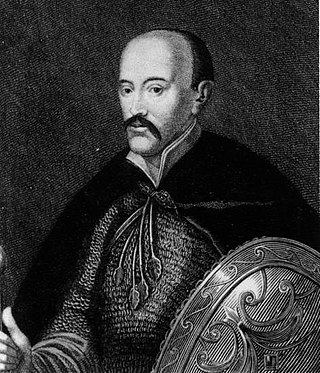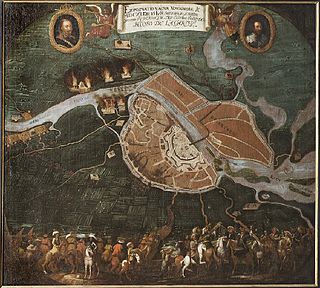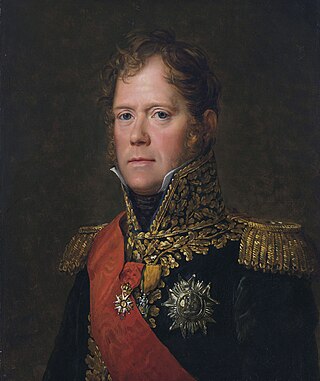
The Battle of Leipzig, also known as the Battle of the Nations, was fought from 16 to 19 October 1813 at Leipzig, Saxony. The Coalition armies of Austria, Prussia, Sweden, and Russia, led by Tsar Alexander I and Karl von Schwarzenberg, decisively defeated the Grande Armée of French Emperor Napoleon Bonaparte. Napoleon's army also contained Polish and Italian troops, as well as Germans from the Confederation of the Rhine. The battle was the culmination of the German Campaign of 1813 and involved 560,000 soldiers, 2,200 artillery pieces, the expenditure of 400,000 rounds of artillery ammunition, and 133,000 casualties, making it the largest battle of the Napoleonic Wars, and the largest battle in Europe prior to World War I.

The Battle of Poltava was the decisive and largest battle of the Great Northern War. The Russian army under the command of Tsar Peter I defeated the Swedish army under the command of Carl Gustaf Rehnskiöld. The battle put an end to the status of the Swedish Empire as a European great power, as well as its eastbound expansion, and marked the beginning of Russian supremacy in eastern Europe.

The Franco-Swedish War or Pomeranian War was the first involvement by Sweden in the Napoleonic Wars. The country joined the Third Coalition in an effort to defeat France under Napoleon Bonaparte.

The Deluge was a series of mid-17th-century military campaigns in the Polish–Lithuanian Commonwealth. In a wider sense, it applies to the period between the Khmelnytsky Uprising of 1648 and the Truce of Andrusovo in 1667, comprising the Polish theatres of the Russo-Polish and Second Northern Wars. In a stricter sense, the term refers to the Swedish invasion and occupation of the Commonwealth as a theatre of the Second Northern War (1655–1660) only; in Poland and Lithuania this period is called the Swedish Deluge, or less commonly the Russo–Swedish Deluge due to the simultaneous Russo-Polish War. The term "deluge" was popularized by Henryk Sienkiewicz in his novel The Deluge (1886).

The Ingrian War was a conflict fought between the Swedish Empire and the Tsardom of Russia which lasted between 1610 and 1617. It can be seen as part of Russia's Time of Troubles and is mainly remembered for the attempt to put a Swedish duke on the Russian throne. It ended with a large Swedish territorial gain in the Treaty of Stolbovo, which laid an important foundation to Sweden's Age of Greatness.

Aleksander Korwin Gosiewskide armis Ślepowron, was a Polish nobleman, military commander and diplomat, Lithuanian Field-Quartermaster since 1630, Palatine-Governor of Smolensk from 1625, Lithuanian Great-Quartermaster since 1615, Speaker of the Parliament in 1613, Great-Secretary of the Grand Duchy of Lithuania from 1610 and District-Governor of Wieliż, Puńsk, Kupise, Biel, and Markowa.

The siege of Plevna or Pleven, was a major battle of the Russo-Turkish War of 1877–1878, fought by the joint army of Russian Empire and Kingdom of Romania against the Ottoman Empire. After the Russian army crossed the Danube at Svishtov, it began advancing towards the centre of modern Bulgaria, with the aim of crossing the Balkan Mountains to Constantinople, avoiding the fortified Turkish fortresses on the Black Sea coast. The Ottoman army led by Osman Pasha, returning from Serbia after a conflict with that country, was massed in the fortified city of Pleven, a city surrounded by numerous redoubts, located at an important road intersection.

Tikhvin is a town and the administrative center of Tikhvinsky District in Leningrad Oblast, Russia, located on both banks of the Tikhvinka River in the east of the oblast, 200 kilometers (120 mi) east of St. Petersburg. Tikhvin is also an industrial and cultural center of the district, as well as its transportation hub. Population: 58,459 (2010 Census); 63,338 (2002 Census); 71,352 (1989 Soviet census).

The Battle of Prague, which occurred between 25 July and 1 November 1648 was the last action of the Thirty Years' War. While the negotiations for the Peace of Westphalia were proceeding, the Swedes took the opportunity to mount one last campaign into Bohemia. The main result, and probably the main aim, was to loot the fabulous art collection assembled in Prague Castle by Rudolf II, Holy Roman Emperor (1552–1612), the pick of which was taken down the Elbe in barges and shipped to Sweden.

Count Carl Gustav Rehnskiöld was a Swedish Field Marshal (fältmarskalk) and Royal Councillor. He was mentor and chief military advisor to King Charles XII of Sweden, and served as deputy commander-in-chief of the Carolean Army, an army he assisted both in its education and development.

The siege of Smolensk, also known as the Smolensk Defense in Russia, lasted 20 months between 29 September 1609 to 13 June 1611, when the Polish army besieged the Russian city of Smolensk during the Polish–Russian War (1609–1618).

The Third Swedish Crusade to Finland was a Swedish military expedition against the pagan Karelians from 1293 to 1295 in which the Swedes successfully expanded their borders eastwards and gained further control of their lands in Finland.

The Crossing of the Düna took place during the Great Northern War on July 19, 1701 near the city of Riga, present-day Latvia. The Swedish king Charles XII was in hot pursuit of king Augustus II the Strong of the Polish–Lithuanian Commonwealth and Saxony. The crossing was easily made, and the coalition troops were quickly broken and retreated.
The Battle of Kokenhausen was a major battle opening the Polish–Swedish War (1600–1611). It took place on the 13 June (O.S.) or 23 June (N.S.) 1601 near Koknese in Livonia. In the battle, Polish forces defeated the Swedish relief force and captured the besieging force, relieving the Polish garrison. The battle is notable as one of the greatest victories of the Polish hussars, who defeated their numerically superior Swedish adversaries.

The Bremen-Verden Campaign was a conflict during the Northern Wars in Europe. From 15 September 1675 to 13 August 1676 an anti-Swedish coalition comprising Brandenburg-Prussia, the neighbouring imperial princedoms of Lüneburg and Münster, and Denmark-Norway, conquered the Duchies of Bremen and Verden.

The siege of Pskov between 9 August and 27 October 1615 was the final battle of the Ingrian War with which the hostilities ended. Swedish forces under Gustav II Adolf laid siege to Pskov, but were unable to take the city.

The Battle of Bronnitsy was part of the Ingrian War.

The capture of Novgorod occurred during the Time of Troubles, which entailed the Swedish occupation of Novgorod from July 1611 until its return to Russia in 1617 as a result of the Treaty of Stolbovo.

The Combat of Rosslau was fought in the War of the Sixth Coalition on 29 September 1813, near Rosslau, Germany. Michel Ney attacked the Swedish bridgehead at the Elbe, to stop the Army of the North from crossing the river. The Swedish commander Johan August Sandels counterattacked and chased the French for 5 km (3 mi) before being forced to retire himself. About 350 Swedes were dead and wounded while the French had 600 losses. The battle had no strategic effects, but it was one of very few times in the war that a Swedish force was fully committed in battle.

The Battle of Bamberg took place on 9 March 1632 during the Thirty Years' War. The army of the Catholic League led by Count Tilly surprised and routed the Swedes led by Gustav Horn and captured the city.



















